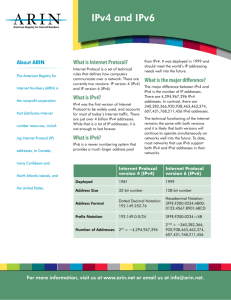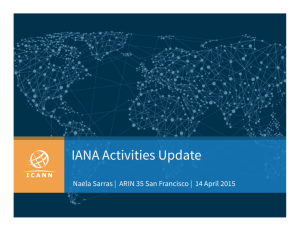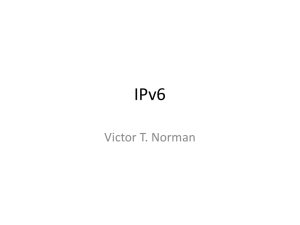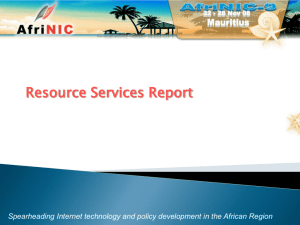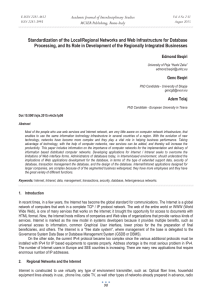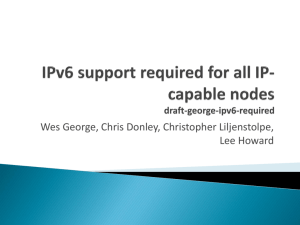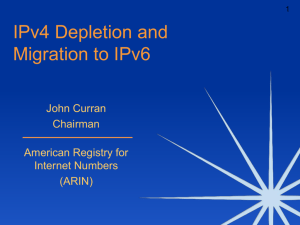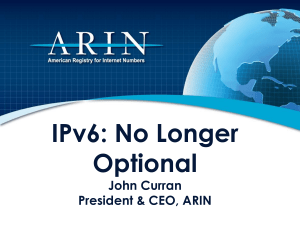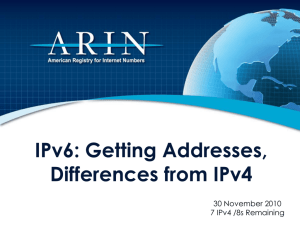Latin American and Caribbean Internet Addresses Registry
advertisement
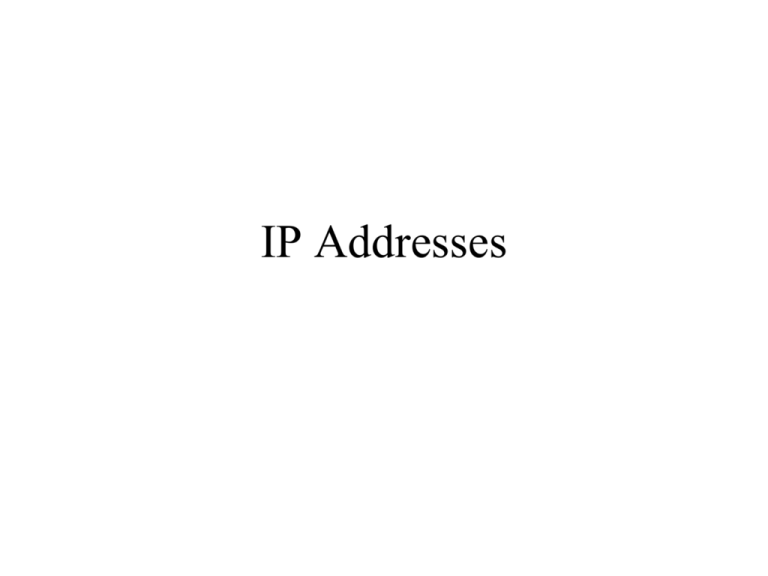
IP Addresses IP Addresses • An identifier for a computer or device on a TCP/IP network. Networks using the TCP/IP protocol route messages based on the IP address of the destination. The format of an IP address is a 32-bit numeric address written as four numbers separated by periods. Each number can be zero to 255. For example, 1.160.10.240 could be an IP address. IP Address Classes • • • • Class A - 168.212.226.204 supports 16 million hosts on each of 127 networks Class B - 168.212.226.204 supports 65,000 hosts on each of 16,000 networks – NDUS has two Class B addresses • 134.129.xxx.xxx • 134.234.xxx.xxx Eastern ND Western ND • Class C - 168.212.226.204 • supports 254 hosts on each of 2 million networks IPv4 vs. IPv6 • IPv4 – 32 bits used for address – 4,294,967,296 – Addresses not assigned by geographic region (see map) • IPv6 – 128 bits used for address – 340,282,366,920,938,463,374,607,431,768,211,456 – That about 3.7x10^21 addresses per square inch of the earth’s surface – Addresses will be assigned by geographic region IPv4 vs. IPv6 • IPv4 addresses written as four octets (8 bits) separated by periods. – 134.129.67.235 • IPv6 address written as eight 4-digit (16-bit) hexadecimal numbers separated by colons. – 1080:0:0:0:0:800:0:417A IPv4-to-IPv6 • IPv4 Compatible Address – 0:0:0:0:0:0:w.x.y.z (or ::w.x.y.z) – Is used by dual-stack nodes that are communicating with IPv6 over an IPv4 infrastructure – The last four octets (w.x.y.z) represent the dotted decimal representation of an IPv4 address Loopback address • 127.0.0.0 – Network number that cannot be assigned to any network • 127.0.0.1 – The loopback address – Used for diagnostic testing of the local TCP/IP installation Automatic Private IP Addressing (APIPA) • 169.254.x.x • IP addresses are self-assigned when the computer asks for an IP address and no one responds. • i.e. the computer cannot reach a DHCP server over the network. Network & Broadcast addresses • You cannot assign a network number to a computer or any other host on the network. • You cannot assign the highest number on a network to a host. This address is interpreted as a broadcast message for the subnet. Reserved IP Network Numbers Network number Subnet mask IP address range 10.0.0.0 255.0.0.0 10.0.0.1-10.255.255.255 172.16.0.0-172.31.0.0 255.255.0.0 172.16.0.1-172.31.255.255 192.168.0.0 255.255.255.0 192.168.0.1-192.168.255.255 Designed for use on a private network behind a Network Address Translation (NAT) device, such as a firewall, proxy servers, or some routers. A NAT device can be used to disguise local or internal IP addresses from outside networks. For more reserved addresses see: http://en.wikipedia.org/wiki/Reserved_IP_addresses Uniform Resource Locator • http://www.ndsu.nodak.edu/pubweb/~latimer/index.html#events • • • • • http:// www.ndsu.nodak.edu /ndsu/latimer/ index.html #events communication protocol web server hosting the page path to the page on the host server filename of the page anchor in the page IP & Domain Name Examples • IP: 134.129.67.85 • URL: gdc.busad.ndsu.nodak.edu • IP: 134.129.67.235 • URL: dyn235.minard-67.ndsu.nodak.edu ICANN • Internet Corporation for Assigned Names and Numbers • a private sector, nonprofit organization • responsibility for IP address space allocation, protocol parameter assignment, domain name system management and root server system management functions previously performed under U.S. Government contract • ICANN's diverse board consists of nineteen Directors, nine At-Large Directors, who serve one-year terms and will be succeeded by At-Large Directors elected by an at-large membership organization. None of the present interim directors may sit on the board once the permanent members are selected. IP Address Registries • Regional Internet Registries: • American Registry for Internet Numbers, ARIN • Réseaux IP Européens Network Coordination Centre, RIPE NCC • Asia Pacific Network Information Centre, APNIC • Latin American and Caribbean Internet Addresses Registry, LACNIC Internet Assigned Numbers Authority http://www.iana.org/ • Generic Top-Level Domains – http://www.iana.org/gtld/gtld.htm • ccTLD Database (country codes) – http://www.iana.org/cctld/cctld-whois.htm • IP Address Services – http://www.iana.org/ipaddress/ip-addresses.htm New Top-Level Domain Names (TLDs) • ICANN is accepting applications for new TLDs. – Application window Jan. 12, 2012 to Apr. 12, 2012 – Application fee: $185,000 – Annual fee: $25,000 • Intent is to move towards more descriptive names • Companies (organizations) can create – Brand domains e.g. .pepsi – Generic domains e.g. .car .coke .green • http://mashable.com/2011/06/20/icann-top-level-domains/
